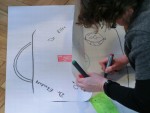Do you want to collect feedback during your course or conference? Try the happiness door!…
The Feedback Door
If there’s one thing I am still learning to cope with, it’s criticism. But I figured out that constructive criticism truly improves what I do, like nothing else. It’s, after all, one of the first principles of Agile: keep the feedback loop as short as possible.
These days I use ongoing feedback to improve my courses while giving them. This is how it works: there’s one door in the course room, preferably the one leading to the coffee corner, that I name the “feedback door” and you should not go through the door without giving some feedback on the last topic. No matter if it’s a fundamental issue or only a smiley, you put something on the door.
I started implementing ongoing feedback with sticky notes in my courses for a very simple reason: when participants have the topic fresh in mind, I assumed the feedback they would give me would be more accurate. And that could help me improve my courses when, after the course, I went through all the sticky notes I received. The reason I checked the feedback afterwards was that I didn’t like confronting myself with those bloody sticky notes directly during the course. Because what to do when they didn’t like my sweater? What if they didn’t like the word ‘ehm’ as the start of every other sentence? Or even worse, what if they thought my courseware was ridiculous?
But, contrary to my fears, the feedback notes never turned out to be problematic, and many were even compliments! And, more important, I came to realize that it was important to read them immediately during the course. Because, though most feedback doesn’t require immediate action, there are some others I can act upon straight away. Like “maybe you could slow down the laser pointer a bit”. Or “we have trouble hearing you in the back of the room, could you make sure you face us while talking”. Immediate feedback makes those two days more effective, and more fun.
During last week’s course in Gouda I made another improvement: I added a happiness index to the feedback door. Students place their sticky note on a scale of one to five, indicating how they feel. 1 = very negative. 5 = very positive. Now the feedback door is not only about qualitative feedback, but also about people’s mood during the course. Which, if necessary, I can try to manipulate with strawberries dipped in chocolate…







